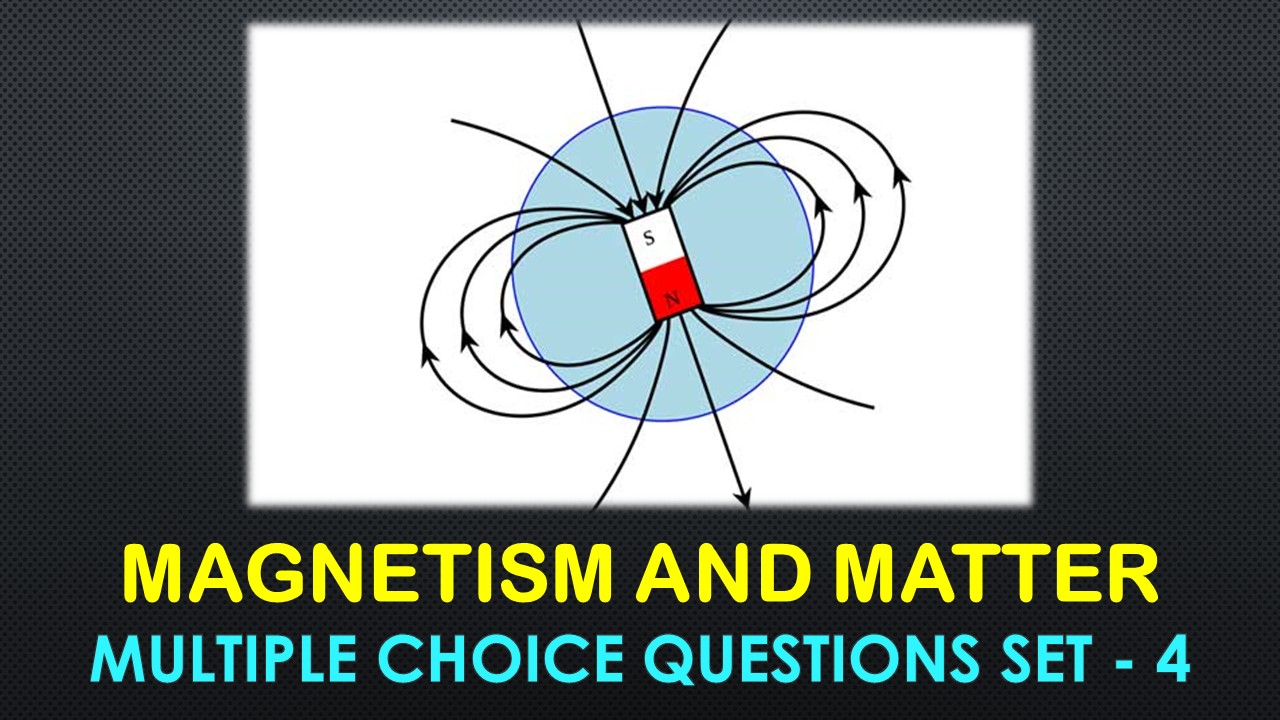CBSE Class 12 Magnetism and Matter Multiple Choice Questions with Answers. MCQ Questions Class 12 Magnetism and Matter with Answers Is Prepared Based on Latest Exam Pattern. Students can solve NCERT Class 12 Magnetism and Matter MCQs with Answers to know their preparation level.
Students who are searching for NCERT MCQ Questions for Class 12 Magnetism and Matter with Answers are compiled here to get good practice on all fundamentals. Know your preparation level on MCQ Questions for Class 12 Magnetism and Matter with Answers. You can also verify your answers from our provided MCQ Class 12 Magnetism and Matter with Answers. So, ace up your preparation with MCQ of Class 12 Physics Examinations.
MCQ Questions Class 12 Magnetism and Matter with Answers - Set - 4
Question 1:
The best material for the core of a transformer is
(a) mild steel
(b) stainless steel
(c) soft iron
(d) hard steel
Correct Answer – (C)
Question 2 :
A frog can be levitated in a magnetic field produced by a current in a vertical solenoid placed below the frog. This is possible because the body of the frog behaves as :
(a) paramagnetic
(b) diamagnetic
(c) ferromagnetic
(d) antiferromagnetic
Correct Answer – (C)
Question 3 :
The Mariner’s compass is provided with Gimbals arrangement so as to :
(a) keep the needle always horizontal
(b) give a direct reading of declination
(c) give the direct value of dip
(d) all of the above
Correct Answer – (C)
Question 4 :
The magnetic field of earth is due to:
(a) induction effect of the sun
(b) the presence of a large magnet at the centre of the earth
(c) interaction of cosmic rays with the current of earth
(d) motion and distribution of some material in an outside the earth
Correct Answer – (D)
Question 5 :
The force between two parallel wire 2 × 10-7 Nm-1, placed 1 m apart to each other in vacuum. The electric current flowing through the wires is:
(a) 1 A
(b) zero
(c) 5 × 106 A
(d) 2 × 10-7 A
Correct Answer – (A)
MCQ Questions Class 12 Magnetism and Matter with Answers
Question 6 :
Domain formation is the necessary feature of :
(a) ferromagnetism
(b) diamagnetism
(c) paramagnetism
(d) all of these
Correct Answer – (A)
Question 7 :
The radius of curvature of the path of charged particle in a uniform magnetic file is directly proportional to the
(a) charge on fie particle
(b) Momentum of particle
(c) energy of particle
(d) Strength of field
Correct Answer – (B)
Question 8 :
In a bar magnet, magnetic lines of force z :
(a) are produced only at north pole like rays of light from a bulb
(b) starts from north pole and ends at the south pole
(c) emerge in circular paths from the middle of the bar
(d) run continuously through the bar and outside
Correct Answer – (B)
Question 9 :
Which of the following has higher magnetic susceptibility?
(a) diamagnetic
(b) paramagnetic
(c) ferromagnetic
(d) None of these
Correct Answer – (C)
Question 10 :
In a moving coil galvanometer, we use a radial magnetic field so that the galvanometer scale is :
(a) exponential
(b) linear
(c) algebraic
(d) logarithmic
Correct Answer – (B)
- NCERT Solutions Class 11 Chemistry Chapter 1 : Some Basic Concepts of Chemistry
- NCERT Solutions Class 11 Chemistry Chapter 2 : Structure Of The Atom
- NCERT Solutions Class 11 Chemistry Chapter 3 : Classification of Elements and Periodicity in Properties
- NCERT Solutions Class 11 Chemistry Chapter 4 : Chemical Bonding and Molecular Structure
- NCERT Solutions Class 11 Chemistry Chapter 5 : States of Matter
- NCERT Solutions Class 11 Chemistry Chapter 6 : Thermodynamics
- NCERT Solutions Class 11 Chemistry Chapter 7 : Equilibrium
- NCERT Solutions Class 11 Chemistry Chapter 8 : Redox Reactions
- NCERT Solutions Class 11 Chemistry Chapter 9 : Hydrogen
- NCERT Solutions Class 11 Chemistry Chapter 10 : The s-Block Elements
- NCERT Solutions Class 11 Chemistry Chapter 11 : The p-Block Elements
- NCERT Solutions Class 11 Chemistry Chapter 12 : Organic Chemistry: Some Basic Principles and Techniques
- NCERT Solutions Class 11 Chemistry Chapter 13 : Hydrocarbons
- NCERT Solutions Class 11 Chemistry Chapter 14 : Environmental Chemistry




